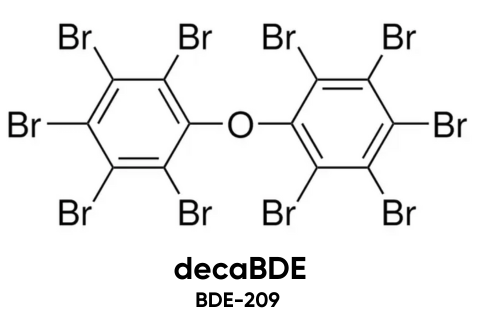
Lionel MURAT
Lionel est co-fondateur de CIKLab. Ancien responsable de contrôle qualité, il est spécialisé dans la sous-traitance des analyses alimentaires.
PBDEs, or polybrominated diphenyl ethers, are a class of brominated chemical compounds used as brominated flame retardants (BFRs) in various products, including plastics, textiles, and electronic devices. Due to their chemical structure and low degradability, PBDEs persist in the environment, classifying them as Persistent Organic Pollutants (POPs). Their lipophilic nature makes them particularly concerning as they easily enter the food chain and have adverse effects on human health, notably as endocrine disruptors.
PBDEs belong to the Brominated Flame Retardants (BFR) category, along with:
Bromodiphenyl ethers (BDE) encompass 209 possible congeners, based on the level of bromination (from monoBDE to decaBDE), and for each bromination level, there are several isomers.
According to the EFSA, 8 congeners are of greatest concern in the food chain (CONTAM Panel): BDE-28, BDE-47, BDE-99, BDE-100, BDE-153, BDE-154, BDE-183, and BDE-209, and can be considered as markers of choice.
The highest exposure levels involve BDE-47 and BDE-209

PBDEs can contaminate the food chain due to their highly lipophilic nature. They particularly contaminate items rich in fat, such as animal products, especially fatty fish, seafood, meat, butter, and eggs. Animal fats tend to accumulate these compounds, leading to human exposure through food consumption. This information is sourced from the ESTEBAN study conducted by Santé publique France.
PBDEs can be released into the environment during the manufacturing, use, and disposal of products containing them. Once in the environment, they can be absorbed by aquatic and terrestrial organisms, accumulating in the food chain
The detection and quantification of PBDEs in food products are typically carried out using gas chromatography coupled with mass spectrometry (GC-MS). More recently, high-resolution gas chromatography-high-resolution mass spectrometry (HRGC-HRMS) with isotopic dilution (ID) has become increasingly common for this purpose

Lionel est co-fondateur de CIKLab. Ancien responsable de contrôle qualité, il est spécialisé dans la sous-traitance des analyses alimentaires.
Koalyz SAS
107, allée François Mitterrand
76100 ROUEN – France